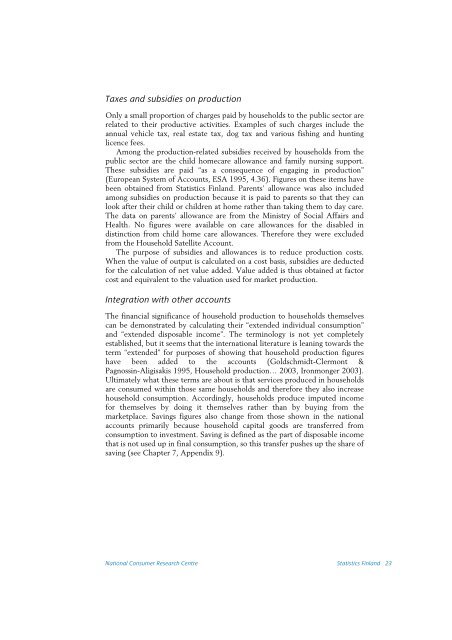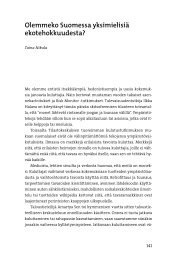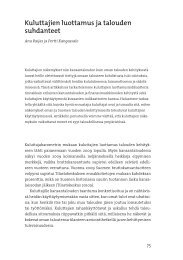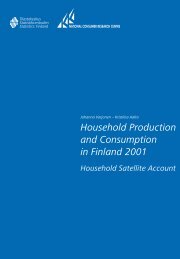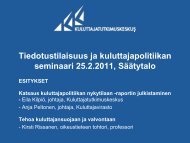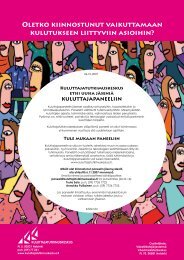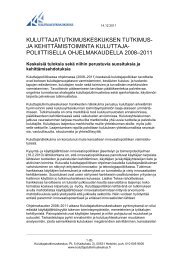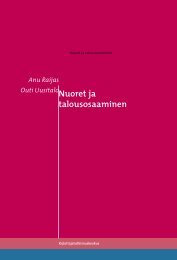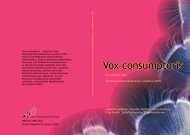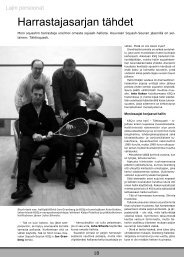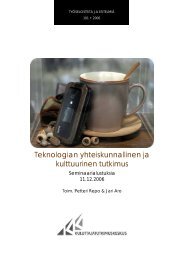Household Production and Consumption in Finland 2001
Household Production and Consumption in Finland 2001
Household Production and Consumption in Finland 2001
You also want an ePaper? Increase the reach of your titles
YUMPU automatically turns print PDFs into web optimized ePapers that Google loves.
Taxes <strong>and</strong> subsidies on production<br />
Only a small proportion of charges paid by households to the public sector are<br />
related to their productive activities. Examples of such charges <strong>in</strong>clude the<br />
annual vehicle tax, real estate tax, dog tax <strong>and</strong> various fish<strong>in</strong>g <strong>and</strong> hunt<strong>in</strong>g<br />
licence fees.<br />
Among the production-related subsidies received by households from the<br />
public sector are the child homecare allowance <strong>and</strong> family nurs<strong>in</strong>g support.<br />
These subsidies are paid “as a consequence of engag<strong>in</strong>g <strong>in</strong> production”<br />
(European System of Accounts, ESA 1995, 4.36). Figures on these items have<br />
been obta<strong>in</strong>ed from Statistics F<strong>in</strong>l<strong>and</strong>. Parents’ allowance was also <strong>in</strong>cluded<br />
among subsidies on production because it is paid to parents so that they can<br />
look after their child or children at home rather than tak<strong>in</strong>g them to day care.<br />
The data on parents’ allowance are from the M<strong>in</strong>istry of Social Affairs <strong>and</strong><br />
Health. No figures were available on care allowances for the disabled <strong>in</strong><br />
dist<strong>in</strong>ction from child home care allowances. Therefore they were excluded<br />
from the <strong>Household</strong> Satellite Account.<br />
The purpose of subsidies <strong>and</strong> allowances is to reduce production costs.<br />
When the value of output is calculated on a cost basis, subsidies are deducted<br />
for the calculation of net value added. Value added is thus obta<strong>in</strong>ed at factor<br />
cost <strong>and</strong> equivalent to the valuation used for market production.<br />
Integration with other accounts<br />
The f<strong>in</strong>ancial significance of household production to households themselves<br />
can be demonstrated by calculat<strong>in</strong>g their “extended <strong>in</strong>dividual consumption”<br />
<strong>and</strong> “extended disposable <strong>in</strong>come”. The term<strong>in</strong>ology is not yet completely<br />
established, but it seems that the <strong>in</strong>ternational literature is lean<strong>in</strong>g towards the<br />
term “extended” for purposes of show<strong>in</strong>g that household production figures<br />
have been added to the accounts (Goldschmidt-Clermont &<br />
Pagnoss<strong>in</strong>-Aligisakis 1995, <strong>Household</strong> production… 2003, Ironmonger 2003).<br />
Ultimately what these terms are about is that services produced <strong>in</strong> households<br />
are consumed with<strong>in</strong> those same households <strong>and</strong> therefore they also <strong>in</strong>crease<br />
household consumption. Accord<strong>in</strong>gly, households produce imputed <strong>in</strong>come<br />
for themselves by do<strong>in</strong>g it themselves rather than by buy<strong>in</strong>g from the<br />
marketplace. Sav<strong>in</strong>gs figures also change from those shown <strong>in</strong> the national<br />
accounts primarily because household capital goods are transferred from<br />
consumption to <strong>in</strong>vestment. Sav<strong>in</strong>g is def<strong>in</strong>ed as the part of disposable <strong>in</strong>come<br />
that is not used up <strong>in</strong> f<strong>in</strong>al consumption, so this transfer pushes up the share of<br />
sav<strong>in</strong>g (see Chapter 7, Appendix 9).<br />
National Consumer Research Centre Statistics F<strong>in</strong>l<strong>and</strong> 23


